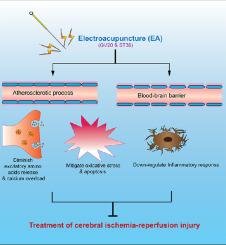Clinical Complementary Medicine and Pharmacology Pub Date : 2023-03-24 , DOI: 10.1016/j.ccmp.2023.100086 Huanyuan Wang , Xifa Xu , Zekun Wang , Gonglei Yue , Bin Tang , Qingchen Zhou , Changzhen Gong , Kaili Wang , Guangzhong Du , Yan Li

|
Background
Electroacupuncture (EA) therapy, as a combination of electric stimulation and traditional acupuncture technology, is currently an important mean for treatment of ischemic stroke and post-stroke rehabilitation in China. Because of its remarkable therapeutic effect, it has been widely used in hospitals and clinic, however, the detailed mechanism remains unclear.
Objective
This research aims to comprehensively and systematically elucidate the mechanisms of EA treatment at the acupoints of Zusanli (ST36) and Baihui (GV20) on ischemic stroke.
Methods
In this study, EA was performed at 20 h following cerebral ischemia-reperfusion (I/R) in middle cerebral artery occlusion (MCAO) rats, and transcriptomic changes of various molecules in ischemic hippocampal neurons of rats in Sham, I/R and EA groups was detected by RNA-Sequencing (RNA-Seq).
Results
Thus, we detected 18 significantly different genes related to atherosclerosis (AS), including lipid metabolism, thrombosis, monocytes and vascular smooth muscle cells. And, we detected 10 significantly different genes related to oxidative stress and apoptosis and 10 significantly different genes related to calcium overload and excitatory amino acids release. As well as, we detected 19 significantly different genes related to blood-brain barrier (BBB) and 22 significantly different genes related to inflammatory response.
Conclusion
In conclusion, EA can play a role in treating ischemic stroke through a variety of mechanisms, including atherosclerosis, oxidative stress, apoptosis, calcium overload, excitatory amino acids release, blood-brain barrier (BBB) and inflammatory response.
中文翻译:

电针百会、足三里刺激脑缺血再灌注损伤机制的RNA测序研究
背景
电针(electroacupuncture,EA)疗法作为电刺激与传统针灸技术的结合,是目前我国治疗缺血性脑卒中和脑卒中后康复的重要手段。由于其显着的治疗效果,已被广泛应用于医院和临床,但具体机制尚不清楚。
客观的
本研究旨在全面系统地阐明电针足三里 (ST36) 和百会 (GV20) 穴位治疗缺血性脑卒中的机制。
方法
本研究在大脑中动脉闭塞 (MCAO) 大鼠脑缺血再灌注 (I/R) 后 20 小时进行电针,以及 Sham、I/R 和电针大鼠缺血海马神经元中各种分子的转录组学变化通过 RNA 测序 (RNA-Seq) 检测组。
结果
因此,我们检测到 18 个与动脉粥样硬化 (AS) 相关的显着不同的基因,包括脂质代谢、血栓形成、单核细胞和血管平滑肌细胞。并且,我们检测到 10 个与氧化应激和细胞凋亡相关的显着不同的基因,以及 10 个与钙过载和兴奋性氨基酸释放相关的显着不同的基因。此外,我们还检测到 19 个与血脑屏障 (BBB) 相关的显着不同基因和 22 个与炎症反应相关的显着不同基因。
结论
总之,电针可以通过多种机制发挥治疗缺血性中风的作用,包括动脉粥样硬化、氧化应激、细胞凋亡、钙过载、兴奋性氨基酸释放、血脑屏障 (BBB) 和炎症反应。










































 京公网安备 11010802027423号
京公网安备 11010802027423号